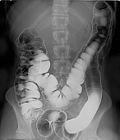Colic flexures
Colic flexures are significant anatomical landmarks in the large intestine of the human body. They are bends in the colon that divide it into different segments. There are two main colic flexures: the hepatic flexure and the splenic flexure. These flexures play a crucial role in the movement and processing of waste material through the digestive system.
Hepatic Flexure[edit]
The hepatic flexure, also known as the right colic flexure, is located near the liver, which explains its name (hepatic relates to the liver). It marks the junction where the ascending colon turns to become the transverse colon. This flexure is situated in the right upper quadrant of the abdomen, just below the liver. The hepatic flexure is an important landmark for surgeons and radiologists as it can be a site for colonic obstruction and other gastrointestinal issues.
Splenic Flexure[edit]
The splenic flexure, or left colic flexure, is found near the spleen, hence its name. It represents the point where the transverse colon turns downward to become the descending colon. Located in the left upper quadrant of the abdomen, the splenic flexure is noted for being the highest point of the colon. Due to its sharp bend and the fact that it is a gravity-dependent area, the splenic flexure can be a site for the accumulation of fecal material, leading to splenic flexure syndrome, characterized by gas and bloating.
Clinical Significance[edit]
Both colic flexures are of clinical significance due to their roles in the passage of fecal matter and their potential involvement in various gastrointestinal conditions. Conditions such as colonic volvulus, colorectal cancer, and diverticulitis can affect the colic flexures. Their anatomical positions also make them critical landmarks in abdominal surgeries and diagnostic procedures like colonoscopy.
Diagnosis and Treatment[edit]
Diagnosis of conditions related to the colic flexures often involves imaging studies such as CT scans, MRIs, and X-rays, in addition to colonoscopy. Treatment varies depending on the underlying condition but may include dietary changes, medications, or surgery.
See Also[edit]
Colic flexures[edit]
-
Large Intestine
-
Diagram of the large intestine
-
Illustration of the intestine
-
Human intestinal tract, as imaged via double-contrast barium enema
Ad. Transform your life with W8MD's Budget GLP-1 injections from $75


W8MD offers a medical weight loss program to lose weight in Philadelphia. Our physician-supervised medical weight loss provides:
- Weight loss injections in NYC (generic and brand names):
- Zepbound / Mounjaro, Wegovy / Ozempic, Saxenda
- Most insurances accepted or discounted self-pay rates. We will obtain insurance prior authorizations if needed.
- Generic GLP1 weight loss injections from $75 for the starting dose.
- Also offer prescription weight loss medications including Phentermine, Qsymia, Diethylpropion, Contrave etc.
NYC weight loss doctor appointmentsNYC weight loss doctor appointments
Start your NYC weight loss journey today at our NYC medical weight loss and Philadelphia medical weight loss clinics.
- Call 718-946-5500 to lose weight in NYC or for medical weight loss in Philadelphia 215-676-2334.
- Tags:NYC medical weight loss, Philadelphia lose weight Zepbound NYC, Budget GLP1 weight loss injections, Wegovy Philadelphia, Wegovy NYC, Philadelphia medical weight loss, Brookly weight loss and Wegovy NYC
|
WikiMD's Wellness Encyclopedia |
| Let Food Be Thy Medicine Medicine Thy Food - Hippocrates |
Medical Disclaimer: WikiMD is not a substitute for professional medical advice. The information on WikiMD is provided as an information resource only, may be incorrect, outdated or misleading, and is not to be used or relied on for any diagnostic or treatment purposes. Please consult your health care provider before making any healthcare decisions or for guidance about a specific medical condition. WikiMD expressly disclaims responsibility, and shall have no liability, for any damages, loss, injury, or liability whatsoever suffered as a result of your reliance on the information contained in this site. By visiting this site you agree to the foregoing terms and conditions, which may from time to time be changed or supplemented by WikiMD. If you do not agree to the foregoing terms and conditions, you should not enter or use this site. See full disclaimer.
Credits:Most images are courtesy of Wikimedia commons, and templates, categories Wikipedia, licensed under CC BY SA or similar.
Translate this page: - East Asian
中文,
日本,
한국어,
South Asian
हिन्दी,
தமிழ்,
తెలుగు,
Urdu,
ಕನ್ನಡ,
Southeast Asian
Indonesian,
Vietnamese,
Thai,
မြန်မာဘာသာ,
বাংলা
European
español,
Deutsch,
français,
Greek,
português do Brasil,
polski,
română,
русский,
Nederlands,
norsk,
svenska,
suomi,
Italian
Middle Eastern & African
عربى,
Turkish,
Persian,
Hebrew,
Afrikaans,
isiZulu,
Kiswahili,
Other
Bulgarian,
Hungarian,
Czech,
Swedish,
മലയാളം,
मराठी,
ਪੰਜਾਬੀ,
ગુજરાતી,
Portuguese,
Ukrainian




